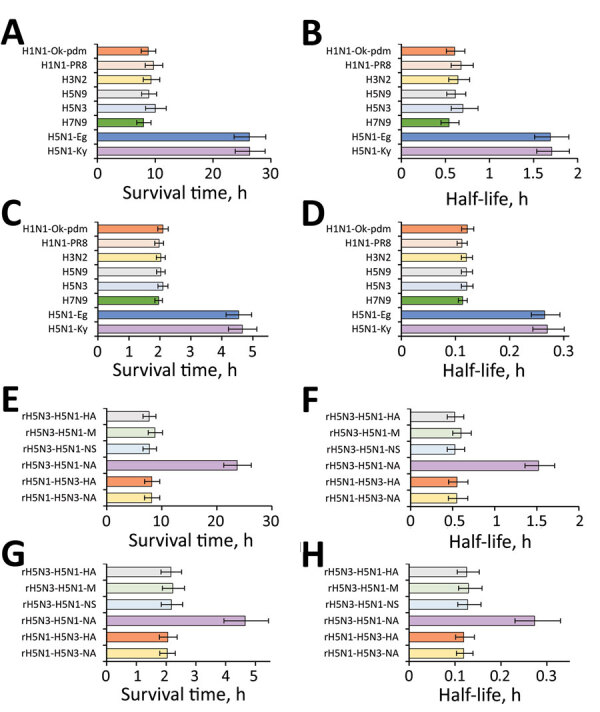Figure 2.

Survival times and half-lives of influenza viruses on plastic and human skin. A, B) Survival times (A) and half-lives (B) of various subtypes of influenza viruses on a plastic surface (Table 1). C, D) Survival times (C) and half-lives (D) of various subtypes of influenza viruses on the surface of human skin (Table 2). E, F) Survival times (E) and half-lives (F) of various recombinant viruses on plastic surfaces (Table 3). G, H) Survival times (G) and half-lives H) of various recombinant viruses on the surface of human skin (Table 4). Survival time is defined as the time until virus on the surface is no longer detected. All half-lives in the graphs refer to the half-life when 103 focus-forming units of virus remained on the skin surface. Data are expressed as median + 95% CI. Data are presented for H5N1-Ky, A/crow/Kyoto/53/04 (H5N1); H5N1-Eg, A/chicken/Egypt/CL6/07 (H5N1); H7N9, A/Anhui/1/23 (H7N9); H5N3, A/duck/Hong Kong/820/80 (H5N3); H5N9, A/turkey/Ontario/7732/66 (H5N9); H3N2, a clinical strain (H3N2); H1N1-PR8, A/Puerto Rico/8/1934 (H1N1); and H1N1-Ok-pdm, A/Osaka/64/2009 (H1N1). A/crow/Kyoto/53/04 (H5N1) was recombined with the neuraminidase or hemagglutinin gene of A/Duck/Hong Kong/820/80 (H5N3), and the recombinant viruses were designated as rH5N1-H5N3-NA or rH5N1-H5N3-HA. In addition, A/Duck/Hong Kong/820/80 (H5N3) was recombined with the neuraminidase, nonstructural protein, matrix protein, or hemagglutinin gene of A/crow/Kyoto/53/04 (H5N1), and the recombinant viruses were designated as rH5N3-H5N1-NA, rH5N3-H5N1-NS, rH5N3-H5N1-M, or rH5N3-H5N1-HA.
